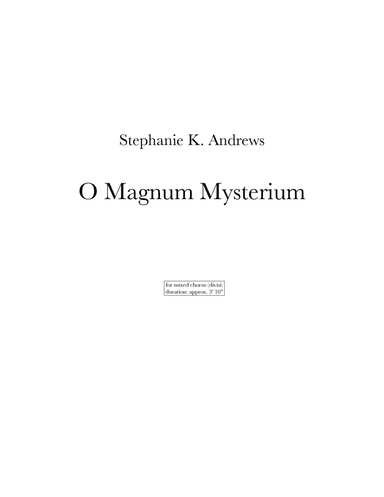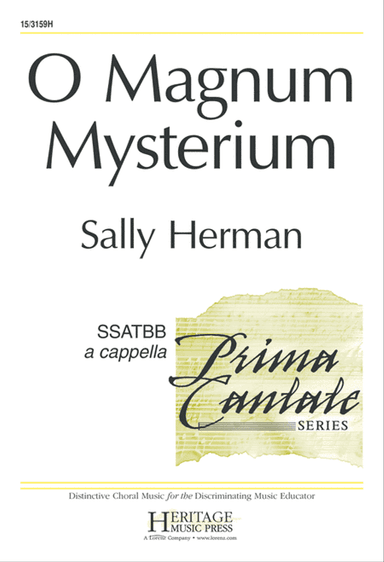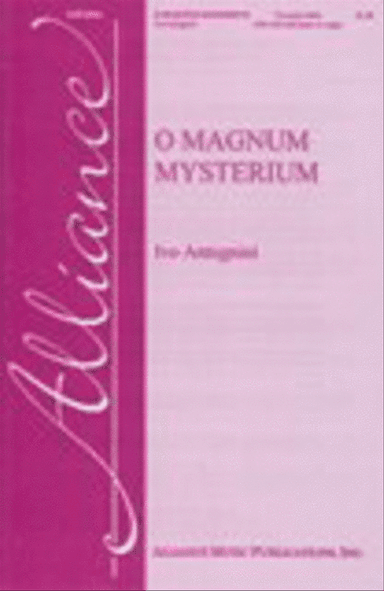Unavailable
O Magnum Mysterium is currently unavailable
We can no longer provide this arrangement through Sheet Music Stores. The listing stays online so you can learn about the piece and explore alternatives.
Try these next steps
- Discover similar sheet music curated for you below.
- Search for “O Magnum Mysterium” across our catalog.
About this arrangement
Choral SSA Choir and Piano SKU: CF.BL1172 Composed by Jonathan Reid. Mjte. 8 pages. Duration 2 minutes, 58 seconds. BriLee Music #BL1172. Published by BriLee Music (CF.BL1172). UPC: 672405010207. Key: D minor. Latin. Liturgical Latin.O Magnum Mysterium is one of my favorite Christmas texts in the choral repertoire, and though it certainly has no shortage of beautiful settings, I chose to set it as a gift to one of my ensembles in 2019. My hope is that this setting is a welcome addition to the repertoire as an appropriately challenging, accompanied piece for developing voices, but one that also has appeal for treble choirs of all ages. Below are some notes for directors and singers: Stressed syllables are always on accented beats, but in contrast, vocal lines sometimes ascend on unaccented beats. Singers should pay careful attention to let the naturally occurring metric accents guide their text stress rather than the varying height of the vocal lines. This can be accomplished through careful study of the Latin text, both the pronunciation as well as the meaning. Enjoy the moments when the metric accents align with an ascending leap (i.e. m. 26). The "great mystery" (magnum mysterium) of the text occurs at mm. 22-29: "that animals should see the newborn Lord, lying in a manger." Notice the first part of the melody (mm. 22-25) is also brought out in the accompaniment at the beginning and end of the piece, and the second half (mm. 26-28) is the first time all three choral parts have their own unique line. Make sure your singers understand the textual connection to the musical ideas occurring in these measures. It should be a special moment. The new section at m. 30 should come down in volume quite a bit to allow for a slow build to the final Soprano 1 "alleluia" in mm. 42-43. Though this section starts at a mezzo-piano, let the consonants be as "crispy" as possible to allow the faster rhythms to sparkle and contrast with the A-section. The crossing of Soprano 1 and Soprano 2 voices at m. 45 is intentional to allow for the most beautiful and musically satisfying lines for the singers, but will need to be rehearsed. The Soprano 2 voices should enjoy their moment as the top voice. As a pianist myself, one of my favorite moments in the piece is mm. 47-50, where the accompanist recaps the "great mystery" melody from m. 22. Allow your pianist some metric freedom in these measures. Some rubato is perfectly acceptable. Beat 1 of m. 53 should have the choir completely exposed, so make sure the accompanist has lifted the damper pedal, and that the choir's vowel is perfectly matched.O Magnum Mysterium is one of my favorite Christmas texts in the choral repertoire, and though it certainly has no shortage of beautiful settings, I chose to set it as a gift to one of my ensembles in 2019. My hope is that this setting is a welcome addition to the repertoire as an appropriately challenging, accompanied piece for developing voices, but one that also has appeal for treble choirs of all ages. Below are some notes for directors and singers: Stressed syllables are always on accented beats, but in contrast, vocal lines sometimes ascend on unaccented beats. Singers should pay careful attention to let the naturally occurring metric accents guide their text stress rather than the varying height of the vocal lines. This can be accomplished through careful study of the Latin text, both the pronunciation as well as the meaning. Enjoy the moments when the metric accents align with an ascending leap (i.e. m. 26). The “great mystery” (magnum mysterium) of the text occurs at mm. 22–29: “that animals should see the newborn Lord, lying in a manger.” Notice the first part of the melody (mm. 22–25) is also brought out in the accompaniment at the beginning and end of the piece, and the second half (mm. 26–28) is the first time all three choral parts have their own unique line. Make sure your singers understand the textual connection to the musical ideas occurring in these measures. It should be a special moment. The new section at m. 30 should come down in volume quite a bit to allow for a slow build to the final Soprano 1 “alleluia” in mm. 42–43. Though this section starts at a mezzo-piano, let the consonants be as “crispy” as possible to allow the faster rhythms to sparkle and contrast with the A-section. The crossing of Soprano 1 and Soprano 2 voices at m. 45 is intentional to allow for the most beautiful and musically satisfying lines for the singers, but will need to be rehearsed. The Soprano 2 voices should enjoy their moment as the top voice. As a pianist myself, one of my favorite moments in the piece is mm. 47–50, where the accompanist recaps the “great mystery” melody from m. 22. Allow your pianist some metric freedom in these measures. Some rubato is perfectly acceptable. Beat 1 of m. 53 should have the choir completely exposed, so make sure the accompanist has lifted the damper pedal, and that the choir’s vowel is perfectly matched.
Related sheet music

O Great Mystery (O Magnum Mysterium)
graham yates

O Magnum Mysterium

O Magnum Mysterium (arr. Ayotte Custom Musical Engravings)
ayotte custom musical engravings, s. timothy glasscock

O Magnum Mysterium
russell l. robinson

O Magnum Mysterium
sally herman

O magnum mysterium

O MAGNUM MYSTERIUM
aurelio porfiri

O magnum mysterium - SATB
joel yeap

O Magnum Mysterium
ivo antognini

Concerto for Violin and Piano E major, op. 8, No. 1 "Spring"
antonio vivaldi

O Magnum Mysterium (ed. Alice Parker and Robert Shaw)
tomas luis de victoria

O Magnum Mysterium - Euphonium 2 BC/TC
tomás luis de victoria, will roesch